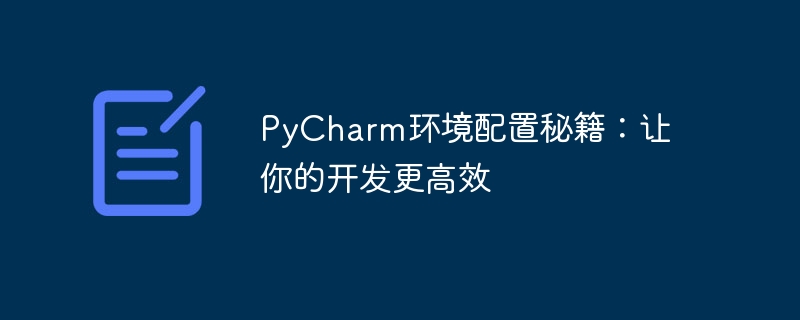Home >Backend Development >Python Tutorial >PyCharm environment configuration tips: make your development more efficient
PyCharm environment configuration tips: make your development more efficient
- 王林Original
- 2024-02-23 15:57:031109browse

PyCharm is a powerful integrated development environment (IDE) that is widely loved by programmers. It provides Python developers with a comprehensive range of functions and tools to make writing, Testing and debugging code becomes more efficient and convenient. However, to give full play to the advantages of PyCharm, it is necessary to configure the environment appropriately. This article will introduce some PyCharm environment configuration tips to help you improve development efficiency.
1. Install PyCharm
First make sure you have downloaded and successfully installed PyCharm. You can download the operating system version that suits you from the JetBrains official website. After the installation is complete, open PyCharm and start configuring your development environment.
2. Configure the interpreter
In PyCharm, configuring the Python interpreter is a very critical step. Make sure PyCharm is using the Python version you require. You can configure it according to the following steps:
- Click "File" -> "Settings" in the menu bar to open the settings window
- Select "Project Interpreter" in the left panel
- Click the gear icon in the upper right corner and select "Add..." to add a new interpreter
- Select the Python interpreter you want and click "OK"
3. Configure code style
Configuring code style in PyCharm can make your code more unified and readable. You can configure the code style according to the following steps:
- Click "File" -> "Settings" in the menu bar to open the settings window
- Select "Editor" in the left panel - > “Code Style”
- Here you can set indentation, spaces, newlines and other code style specifications, configure according to personal preferences and click “Apply” to save
4. Configure code templates
PyCharm also allows you to set code templates, which can speed up coding and improve productivity. You can configure the code template according to the following steps:
- Click "File" -> "Settings" in the menu bar to open the settings window
- Select "Editor" in the left panel - > “Live Templates”
- Here you can add custom code templates, for example, define a template for quickly generating classes. After defining the shortcut keys, you can directly enter the code block
- Click “Apply” "Save configuration
5. Configure version control
PyCharm has built-in support for version control tools, such as Git, SVN, etc. Properly configured version control can help you better manage your code and collaborate with team members. You can configure version control according to the following steps:
- Click "VCS" in the menu bar -> "Import into Version Control" -> "Create Git Repository" to create a new Git repository
- Submit the code to the warehouse and configure the address of the synchronized remote warehouse, which can facilitate teamwork and code management
6. Use code debugging tools
PyCharm provides powerful debugging tools that can help you quickly locate code logic errors. When debugging the configuration, you can set breakpoints, view the values of variables, etc. Using debugging tools can improve code quality and development efficiency.
The above content is only part of the PyCharm environment configuration. Through these configurations and uses, your development work can be made more efficient and convenient. Of course, to take full advantage of PyCharm, you need to continue to learn and explore more of its functions and tools. I hope these PyCharm environment configuration tips can help you.
The above is the detailed content of PyCharm environment configuration tips: make your development more efficient. For more information, please follow other related articles on the PHP Chinese website!
Related articles
See more- Solution when encountering pycharm stuck when opening and slow loading
- How to upgrade win7 to win10 system version - win7 upgrade win10 system tutorial
- Installing Symfony in Docker containers: achieving efficient development
- PyCharm: The secret to becoming an efficient developer, making project packaging easy
- One-click connection to remote server: PyCharm implements efficient development method

